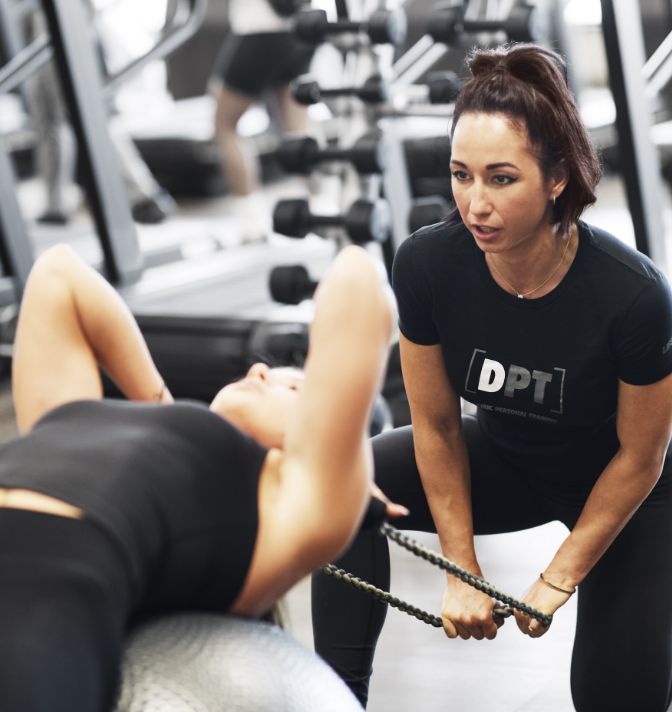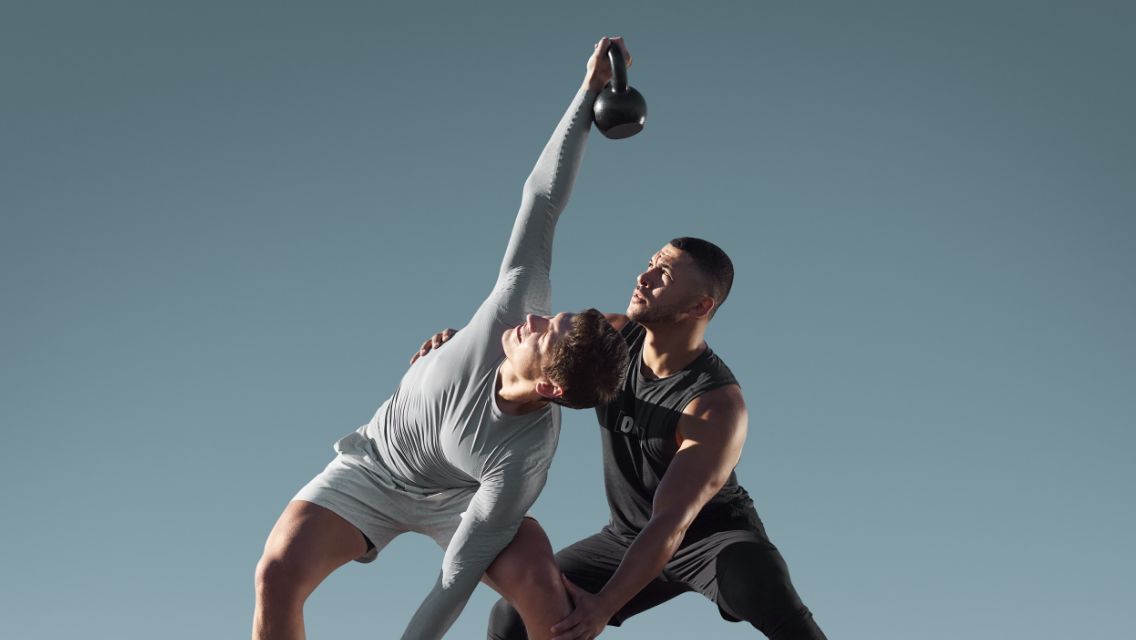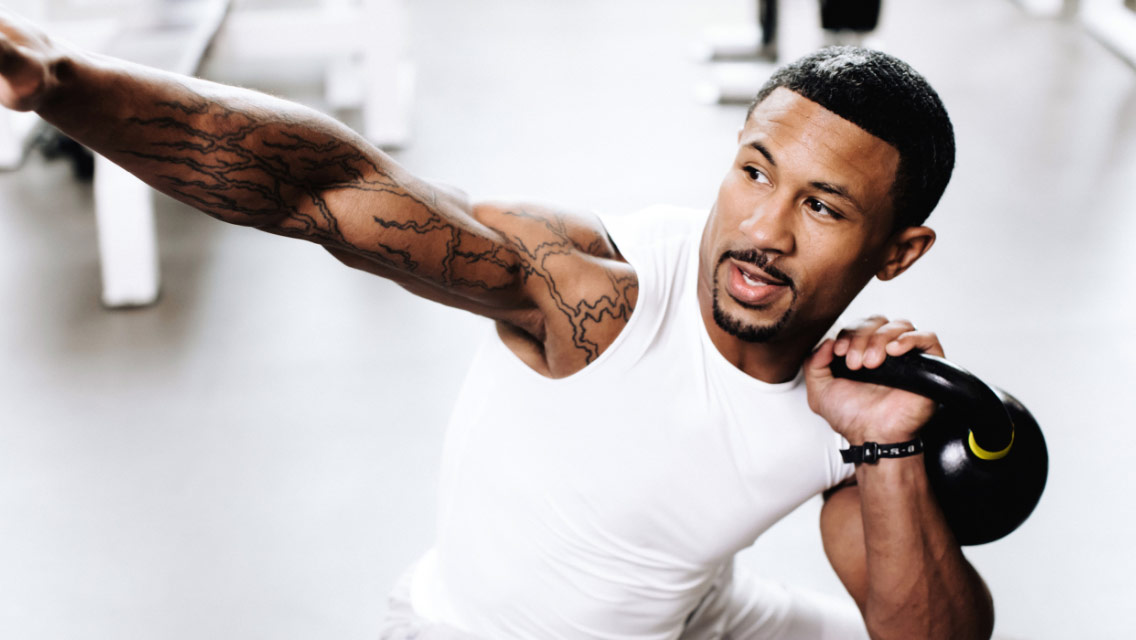Weight training is a powerful tool for changing how your body physically functions. When you build muscle, for example, it positively affects your metabolism — even at rest.
Strength training can also help control blood sugar, lower your cortisol levels, and improve your capacity for storing carbohydrates, among other benefits. Research shows that this can lead to lower body-fat levels over time. (Read more: “9 Strength-Training Benefits For Health, Fitness, and Anti-Aging”)
If you are starting a new strength-training plan or are aiming to add some new moves to your routine, these eight exercises can be particularly effective for improving your body composition.
1. Box Squat
Squatting is one of the best bang-for-your-buck exercises. It works large muscle groups, while also helping to control blood sugar (which is essential for fat loss) and improve your overall metabolism as muscle builds. For beginners, squats can be intimidating, so starting with a box, bench, or chair behind you is a helpful first step.
- Stand directly in front of a knee-height box, bench, or chair with your feet hip width apart or slightly wider.
- Keep your abs engaged and slowly squat down, lowering your glutes toward the box.
- Pause as you sit on the box, but don’t relax. Drive through your heels to stand.
- Repeat for the desired number of reps.
Note: If you need more of a challenge, place a weighted barbell across the back of your shoulders or hold dumbbells in a front-rack position near your shoulders.
2. Glute Bridge
Hinging movements from your hips are key to any effective strength-training program designed to optimize body composition as they work some of the largest muscles in your body. Glute bridges work your backside, which — for most people — is underfiring due to more sedentary lifestyles and long periods of sitting at a desk.
- Lie on your back with your knees bent, keeping your feet flat on the floor and arms at your sides (palms facing down).
- Bracing your core throughout the movement, press your back into the floor and squeeze your glutes, pressing your feet into the floor.
- Lift your hips up fully until there’s a straight line between your shoulders, hips, and knees. Make sure to keep your knees aligned with your heels; don’t let them cave them in.
- Squeeze your glutes in this fully extended position, then slowly return to the starting position with careful control.
- Repeat for the desired number of reps.
Note: If you need more challenge, extend one leg out by 45 degrees. Keep it extended throughout for a single-leg glute bridge, then switch sides.
3. Dumbbell Overhead Press
Another key movement pattern is pressing your arms overhead with weights in your hands. Strengthening your ability to do so can help prevent back and neck issues. As with all strength-training movements, maintaining the proper form is more important than the amount of weight you can lift, so focus first on completing the exercise correctly.
- Stand with your feet hip width apart and hold a dumbbell in each hand at shoulder height with your palms facing forward and elbows close to your body; choose a weight that is challenging for you.
- Keeping your shoulders over your hips, draw your shoulders away from your ears and brace your core, making sure not to arch your back or flare your ribcage.
- Holding this position, press the dumbbells directly overhead, keeping your wrists and forearms perpendicular to the floor.
- Slowly lower back to starting position and repeat for the desired number of reps.
4. Incline Plank
Doing a plank correctly fires several different areas of your body, including your core, which is often a weaker area for many people. To ensure proper form, start with an incline to make the movement easier.
- Stand and face a knee-height bench, box, or chair.
- Place your hands on the edge of the surface, about shoulder width apart. Keeping your shoulders directly over your wrists and arms straight, walk your feet back until there is a straight line between your head, shoulders, hips, knees, and ankles.
- Keep your lower back flat, engage your core, and pull your shoulders away from your ears. Hold this position, making sure not to pike or sink your hips.
Note: As you get stronger, you can slowly lower the inclined surface until you reach the floor to do a traditional plank with correct form.
5. Wall Pushup
Another major muscle group to work when aiming to change body composition is the chest. Working pushups into your routine can enhance your chest movement by recruiting muscles in the arms, shoulders, and core.
Again, form is paramount. The most common mistakes I see with pushups involve sinking the hips, arching the back, not lowering the body enough, not keeping the body in a straight line, or piking the hips up too high. Doing any of these can reduce the efficacy of the pushup and contribute to injury. A wall pushup can help you master form if you’re a beginner.
- Start with your feet and legs shoulder width apart, standing about two feet from a wall with your arms straight out in front of you.
- Place your palms on the wall at shoulder height, slightly wider than shoulder width apart and with your fingers pointing toward the ceiling.
- Bend your elbows and bring your body to the wall, keeping your shoulders, hips, and ankles in a line. Lower your body until your face is about an inch from the wall.
- Push back up to the starting position.
- Repeat for the desired number of reps.
Note: As you get stronger, try pushups using an inclined surface (bench or box) from the incline plank position. Eventually, you can move to a floor pushup.
6. Reverse Lunge
Lunge and step movements help build up your leg strength and power, which fuels almost every activity we do. A reverse lunge can be easier on the knees to start, as you’re not using a decelerating forward motion.
- Stand with your feet shoulder width apart with your shoulders stacked over your hips. It can be helpful to lightly clasp your hands in front of your chest or place them lightly on your hips.
- Step backward with one leg and lower until both knees are at 90 degrees and your back knee is close to the ground. (If you have any pain, stay within a range of motion that doesn’t cause you pain.) Keep your torso upright, core engaged, and shoulders pulled away from your ears.
- Press the heel of your front leg into the ground to rise you back up to the starting position.
- Repeat on other side for desired number of reps.
Note: To add challenge, hold a dumbbell in each hand and keep your hands down at your sides throughout.
7. Dumbbell Bench Press
The bench press has earned its place in the top moves for strength and body composition. It works your upper body and chest, along with your shoulder girdle. Most people who complain of shoulder pain while completing the bench press are likely sacrificing proper form to be able to lift more weight.
- Sit on the edge of the bench with your feet flat on the floor holding a dumbbell in each hand, resting them on your thighs; choose a weight that feels challenging.
- Bracing your core, roll back slowly with control to lie on your back. Lift the dumbbells straight over your body with your wrists over your shoulders and palms facing forward; keep a slight bend in your elbows.
- Squeezing your glutes and drawing your shoulder blades together, inhale as you slowly lower the dumbbells so they are just outside your body across the midline of your chest with your elbows angled about 45 degrees from your body.
- Keeping your glutes engaged, exhale as you push the dumbbells back up and repeat for the desired number of reps.
- When your last rep is complete, slowly bring the dumbbells together on the center of your chest and roll up your body.
8. Pallof Press
Rotational movements are essential to our overall functioning and for preventing injury, so it’s important to include them in your strength-training plan. The pallof press is an easy way to introduce yourself to rotational work, ironically by resisting rotation of the core against a force, which helps build strength and stability. This is a great move to help protect and strengthen your lower back.
- Attach a resistance band to an anchor point at chest height. You can also use a cable machine set at chest height.
- Stand perpendicular to the anchor and take one step backward. Keep your knees hip width apart and slightly bent. Keep your core engaged and shoulders pulled away from your ears.
- Hold the band or handle with both hands with overlapped fingers at the middle of your chest. Step far enough away from the anchor point so there is some tension on the band or cable.
- Extend your arms forward, keeping them parallel to the floor and the rest of your body straight and upright. Pause and bring the cable or band back to the midline of your chest.
- Repeat for the desired number of reps, then repeat with your opposite shoulder facing the anchor.





